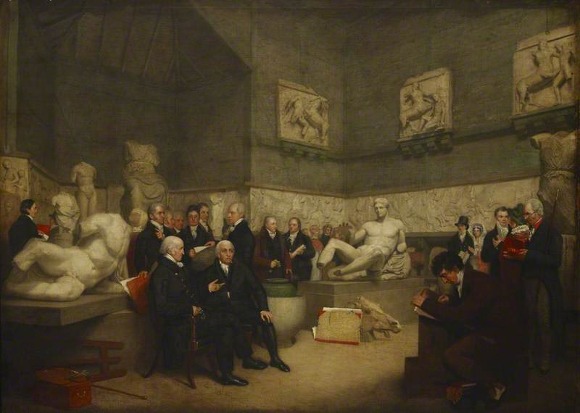John Keats, selected poems Contents
On Seeing the Elgin Marbles: Synopsis and Commentary
Synopsis of On Seeing the Elgin Marbles
Upon seeing the Elgin Marbles Keats is overcome by a sense of his own mortality. The Marbles have immense beauty and grandeur but they used to be part of the frieze on the Parthenon in Athens; now the sculptures are in fragments and in London, no longer a living part of religion but exhibits in a museum.
If such past grandeur can come to this, then human life is even more fragile. Keats sees them and knows he ‘must die’. Yet he also reflects that the immortality of the gods is not necessarily preferable. The gods may live forever but they can never rest from, for instance, keeping the winds fresh for each new morning.
Keats is beset by conflicting emotions: he finds the Grecian grandeur’ marvelous to behold but he also laments the ‘wasting of old Time’.
Commentary on On Seeing the Elgin Marbles
On March 2 1817 Keats went with his friend, the painter Benjamin Haydon, to see the Elgin Marbles which had only recently been obtained by the British Museum in London. He wrote this sonnet the same evening.
Haydon had been one of the most passionate advocates for the purchase of the Marbles for the nation. Indeed he had been a campaigner on their behalf ever since he first saw them in 1806. His campaign reached its climax in 1816 when he wrote a series of articles for The Examiner; Haydon believed that it was the strength of argument expressed in these articles which led to the Marbles being purchased.
The seventh Earl of Elgin (1766-1841), whilst envoy to the Turkish government from 1799-1803, visited Athens in Greece and noticed that many of the classical sculptures were suffering from neglect and decay. At his own expense he made a collection of statues and sculptures, including the frieze from the Parthenon, and shipped them to England. Eventually money was raised for their purchase and they were sold to the British Museum in 1816 for £36,000, rather less than they had cost him. The official name for the sculptures in the British Museum is ‘Parthenon Marbles’.
 Glossary
Glossary
pinnacle and steep: many of the sculptures were taken from the low triangular pediment and thus created to fill a pointed shape. They also portrayed the supreme efforts of conflict between the gods.
 
billowy main: a sea with large waves.
shadow of a magnitude: the idea of something so infinite and awe-inspiring that it can only be dimly understood.
Investigating commentary on On Seeing the Elgin Marbles
- Why do you think Haydon and his circle were so passionate about obtaining the Marbles for the nation?
- Why do you think the Marbles induced in Keats a sense of his own mortality?
A collection of classical Greek marble sculptures by the Greek sculpture Phidius
Classical temple dedicated to the goddess Athena on the Acropolis in Athens
The capital and largest city of Greece, important in the classical era as well as today.
Recently Viewed
-
John Keats, selected poems » On Seeing the Elgin Marbles: Synopsis and Commentary
now -
John Keats, selected poems » Ode to Autumn: Synopsis and Commentary
just now -
John Keats, selected poems » Lamia: Synopsis and commentary
just now -
John Keats, selected poems » Early literary influences on Keats
just now -
John Keats, selected poems » Religious and philosophical context
just now -
John Keats, selected poems » Sleep and Poetry: Language, tone and structure
just now
Related material
Scan and go

Scan on your mobile for direct link.